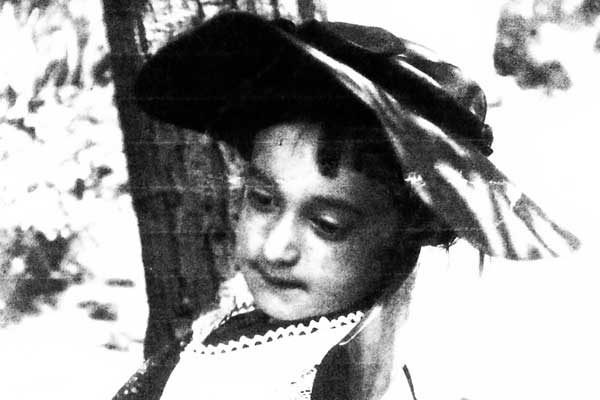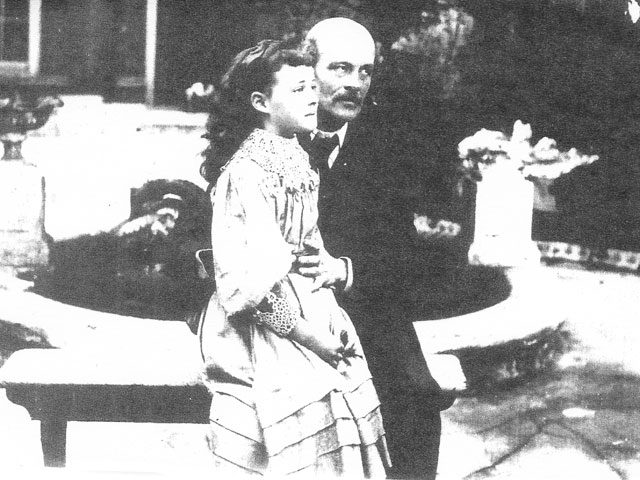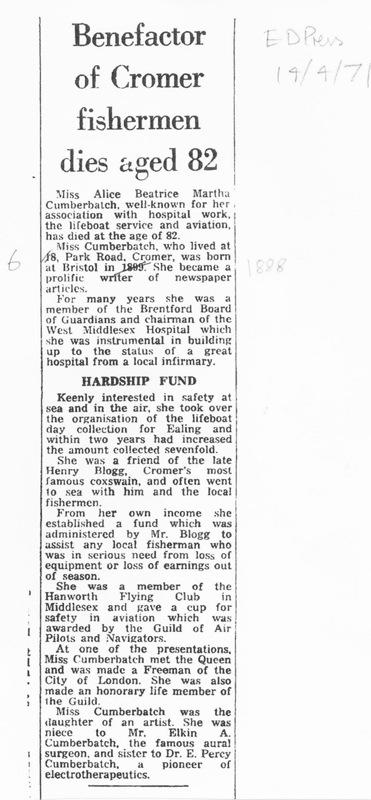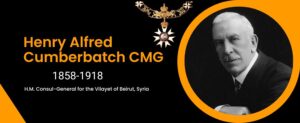Search
Alice Beatrice Martha Cumberbatch 1888-1971
Alice Cumberbatch a small, eccentric woman who chain smoked and made her own blue clothes. Engaged for 20yrs and sued her fiance after he married someone else.

A physically small, eccentric woman. Engaged to be married for 20 years and who sued her fiance for breach of promise when he married someone else. She chain smoked, only wore navy blue and made her own clothes. She also wrote for the Middlesex Gazette, she started the Fisherman’s Benevolent Fund for Cromer, Norfolk fishermen. She raised money for the Royal National Lifeboat Institute (RNLI). She was Chairman of the West Middlesex Hospital, honorary member of the Guild of Air Pilots and Air Navigators and was granted freedom of the City of London on 8 December 1960. She also created The Cumberbatch Trophy which is annually awarded for improvements in the safety of flying.










Alice Cumberbatch’s History
Alice was born on the 15 April 1888 in Burnett, Newton, near Keynsham, Somerset, England. She was baptised at the age of 3 years in the church at Queen Charlton, Somerset, in August 1891. She died 9 April 1971 near her home town of Cromer, Norfolk.
Her parents were Charles Walter Cumberbatch and Pamela, née Pillinger. He was a “gentleman artist”. He lived all his life on the income from his widowed mother’s estate which came from sugar plantations in Barbados. She brought her two sons to England some time after the early death of their father, John Edward Cumberbatch, at the age of 38 in 1854. Charles wanted to be an artist but his mother wanted him to enter the law as a profession. He was placed with a law firm in Bristol but refused to comply with his mother’s wishes and apply himself to legal work. As a result his mother’s Will denied him any access to her capital; it was administered on behalf of Charles Walter and his children by his reliable younger brother and aural surgeon Alfonso Elkin Cumberbatch, who was known to his family as Elkin.
The family story was that Charles took drawing lessons in Bristol, and married the drawing master’s daughter. However, census researches show a less romantic account. Pamela Pillinger’s father was a farm servant, though on her marriage certificate she gave her deceased father’s occupation as a ‘farmer’.
Pamela’s mother Martha was widowed in 1861 when Pamela was only 11 years old. Pamela Cumberbatch’s first family home is the manor house in Queen Charlton, which was leased to them. They had four children:
- Lilian Elizabeth Constance Cumberbatch; born 1879
- Elkin Percy Cumberbatch (who always called Percy); born 1880
- Charles Belgrave Cumberbatch; born 1884. Charles died aged 6 years on 25 March 1891 in Hammersmith, but he is buried in the churchyard at Queen Charlton. Perhaps this explains why both Percy and Alice were baptised in Queen Charlton later in the year 1891 at the ages of 11 and 3 respectively.
- Alice Beatrice Martha Cumberbatch; was the youngest; born in 1888
Alice was three, in 1891, the family had moved to Bradmore House in Hammersmith Broadway so that son, Percy, could go to St. Paul’s Preparatory School in Hammersmith Road. The fees for day boys were approximately £18 per year back then, which is roughly £8,500 today; based on the increase in average earnings inflation to 2007. Bradmore House belonged to George Willins having been left to his adoptive maternal Grandfather, Dr Simpson, by a grateful patient. George, believed to be illegitimate, lived there alone with his guardian, Miss Rae, whom he greatly disliked. There was much speculation about George’s parentage involving Lily Langtry and The Prince of Wales. Another theory was that his father was Fred Archer, the well known jockey. However, George was adopted by “Old Willins” and his wife Pamela Jane, née Simpson, who was said to be particularly keen on adopting that baby and no other. Was this indicative of some relationship? “Old Willins” had been Pamela Jane’s tutor and she had been insistent on marrying him. After some years of marriage, when they lived in Garrett Hall, Dereham, Norfolk, “Old Willins” disappeared from the scene. Pamela eventually moved to London to Bradmore House looking for treatment for cancer. Presumably she died, as George was there, living the life of a gentleman of leisure on a Trust Fund, with his guardian, when the Cumberbatchs leased half the house from him. He and Lily fell in love; the story goes that he threatened to blow his brains out if she didn’t marry him. This did not prove to be necessary, as they were married. They moved to Ealing, to Woodfield House, Woodfield Road, and had three children:
- Hugh Willins
- Pamela Willins
- Sylvia Willins
Lily’s parents Charles and Pamela, with Alice and Percy moved nearby to 79 Madeley Road. When Percy married Isabel they too bought a house nearby in Gordon Road, Ealing. The families were close and visited each other often; they often played terrifying games of Hide and Seek around the house and grounds of Woodfield House. In 1913 most of Bradmore House was demolished to facilitate road widening, but the outer shell of the central part was left. The facade of the beautiful house remains, surrounded by concrete roads and flyovers. Percy went from St. Paul’s School to Keble College, Oxford, and in time became a doctor in Bart’s Hospital. In 1918 Percy Cumberbatch married Isabel Gibbons and had two children:
- Richard Cumberbatch
- Eileen Cumberbatch
They then moved to Ethelburga, at 13 Elmgrove Road, Ealing. While living in Ealing, Alice wrote articles for the local newspaper, the West Middlesex Gazette. Thus she met Mr Chambers, the editor, and they became engaged to be married. It seems that they were engaged for over 20 years, and he appears on many family photographs, but Alice would never “name the day”. It seems that after waiting all this time he got fed up; the story goes that Lily’s daughter Sylvia saw him on the underground with “another woman”. At all events he married someone else, following which Alice sued him successfully for breach of promise, to the mortification of her family.
It was probably a short time after this that Alice used the resulting funds to commission the Cumberbatch Trophy from Omar Ramsden, an internationally renowned silversmith. No doubt she did not wish it to appear that she had sued Mr. Chambers for financial motives. The magnificent cup was to be awarded to the individual or firm who made the greatest contribution to aviation safety and was first to be presented to the Hanworth Club. Later it came by agreement to be presented through the Guild of Air Pilots and Navigators (GAPAN). This was in the 1930s, when flight was very much in the developmental stage.
The Hanworth Airfield was near her home in Ealing and she was a member of the Hanworth Flying Club. Her sister Lily’s oldest child, Hugh Willins was an aeronautical engineer, Alice had been instrumental in helping him to find employment at Hanworth in the difficult years of the 30s. Lily’s older daughter Pamela was married to Omar Ramsden’s son, an actor, though this marriage was annulled in due course. Pamela then married Hugh Buckingham, a Test Pilot who went on to become Managing Director of de Havilland. These are the closest connections found and they explain the choice of Omar Ramsden for the commission. Even today, members of the family have several of his pieces; dressing table sets and other items.
Alice seems to have been a strong minded and determined woman, looked upon as eccentric. She was physically very small and chain-smoked always, lighting one cigarette from another. She always smoked Park Drive, which are thought to be named after her as she lived at 6 Park Drive. Perhaps she knew someone in the tobacco world? In fact a mistake was made as she actually lived in Park Road. She only ever wore navy blue, with a touch of cream, and made all her own clothes, Lily’s granddaughter Teresa, the daughter of Pamela Buckingham, tells how Alice would walk up and down Kensington High Street with her to Derry and Toms’ to buy fabrics and help her make exotic clothes. She also warned Teresa that a particular boyfriend she had at the time was “attractive enough to be dangerous”.
It appears that Alice dominated her gentler sister Lily, though Lily was several years older, and when Lily was considering moving to Cromer where Alice already lived she told her son Hugh she would need him to protect her from Alice. Alice also dominated Isabel, another gentle lady, when she married Alice’s brother Percy. It seems Alice insisted on choosing all the furniture for the couple’s home, selecting heavy Victorian pieces which were not at all to Isabel’s more elegant taste. Alice’s own house in Cromer was filled with antiques, some of which had been in the Great Exhibition.
Men seemed fascinated by Alice. Teresa tells how, a few years before she died in 1971, she brought home a man of about 50 who was very keen to marry her. Teresa’s father Hugh thought he was after her money and chased him away, Teresa remembers that it was all very dramatic and she felt sorry for her Aunt Alice.
Alice achieved a great deal in her public life. Her father had died in 1920 when she was 31 and on the outbreak of war and bombing in 1939 Alice decided to move her mother Pamela, “the Mater”, to Cromer where they had often holidayed with other members of the family. In time Hugh and his family, and hers, Lily and George lived there also. In Cromer Alice started the Fisherman’s Benevolent Fund with the famous coxswain Henry Blogg to help local fishermen in times of poverty. She is still remembered in the town by some of the fishermens’ families. While still living in Ealing she had held events to raise money for the RNLI (Royal National Lifeboat Institute), including one year arranging for a Lifeboat to be drawn through the streets of suburban Ealing to increase awareness of their work. She did a great deal of work as Chairman of the West Middlesex Hospital. As the donor of the Omar Ramsden trophy, she was made an Honorary Life Member of the Guild of Air Pilots and Air Navigators and also made a Freeman of the City of London on 8 December 1960.
Alice died on 9 April 1971, just days before her 83rd birthday. She is buried in the family plot in Cromer, with her sister Lily and brother-in-law George and their daughter Sylvia, Alice and Lily’s mother Pamela. Her obituary appeared in the Eastern Daily Press 14 April 1971.



